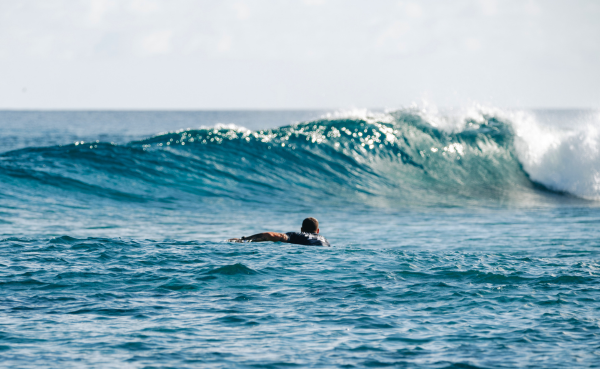Tech Tip: To Rotate or Not? That is the Question
All images courtesy of https://www.worldsurfleague.com

How good is John John Florence? After a recent rocky career path thanks to some undesirable knee surgery, Florence cemented his dominant run at the recent Michelob ULTRA Pure Gold Haleiwa Challenger with a perfect 10 in the Final. You can watch it here.
Most likely you and I won’t ever surf anywhere near his level. But still – what can we learn from the best? This image above perfectly highlights many nuances of his beautiful surfing. But here are just a few things for you to look at:-
- His back foot is out-stretched to the back of the tail pad. Why? This allows him maximum control and turning ability.
- His body weight is heavy over his front foot. We know this because his front knee is bent more than his back knee. Why? This forward weight allows the tail to be free enough to drift.
- He is looking back. Why? Looking back is a form of counter-rotation. It halts the turn suddenly and adds power and weight into the turn.
- His leading arm is raised. Why? This is also a form of counter-rotation which halts the turn suddenly. It works together with the look-back.
So what is counter-rotation I hear you ask? Well obviously it’s the opposite of rotation. But differentiating between the two of these skills is often where the average surfer gets confused – ending up with a confused or half-hearted turn. So think of it like this:-
-Rotate:- when you want to accelerate, flow or carry speed through your turn, you should rotate your upper body in the direction you wish to turn. Examples include a cutback, bottom turn, top turn, floater or carving top turn.

JJF rotating.
-Counter-rotate:- when you want to stop your turn suddenly then this is the time for you to rotate the opposite way of where you were going. Examples include a snap, power gouge or layback carve.

JJF counter-rotating.
Being skilled in both techniques is not easy. If you’re a beginner to upper- intermediate surfer (level 1-7), you should focus on mastering your upper body rotation skills first. Ie: look in the direction of your turn.
But then once you have mastery over those skills (and you have become a high-level 8-10 surfer) then you can start to get fancy with counter-rotation.
So - what then are the take-aways for you to remember out of this?
Rotation in surfing is a bit like a dog chasing its tail. You look at your end point and then rotate your body in that direction. Try this on your next cutback or top turn. It should feel smooth and easy.
But once you’re an advanced surfer who wants to jam a big, power snap into the wave, you should do the exact opposite of rotation – instead look back at your tail and stop any rotation with force.
It seems to work out all right for John John.
Ross
RECENT BLOGS

Surf at the #1 Resort in South East Asia: Nay Palad Hideaway in the Philippines
After reopening its doors in June of 2023, Nay Palad Hideaway on Siargao Island has emerged not just as a reimagined resort but as a destination that epitomises luxury surf travel. Tucked between palm forests and the warm Pacific, it’s where raw island beauty, world class surf, and effortless indulgence collide.

Tropicsurf Access: The Best Maldives Offers in Years
The Maldives is one of our most cherished destinations where perfect waves meet laid back luxury. With surf season running through October, there is still time to chase world class breaks and island bliss.
We have partnered with our trusted resorts to bring you exclusive insider only offers that combine exceptional value with effortless style.

Tropicsurf's First Season at Alphonse Island
After spending our first season at Alphonse Island in the Seychelles, we can confidently say that this is more than just a luxury surf destination. It’s a discovery. One where untouched waves, unspoiled landscapes, and the thrill of uncrowded lineups create an experience that feels rare and authentic in today’s busy world.


